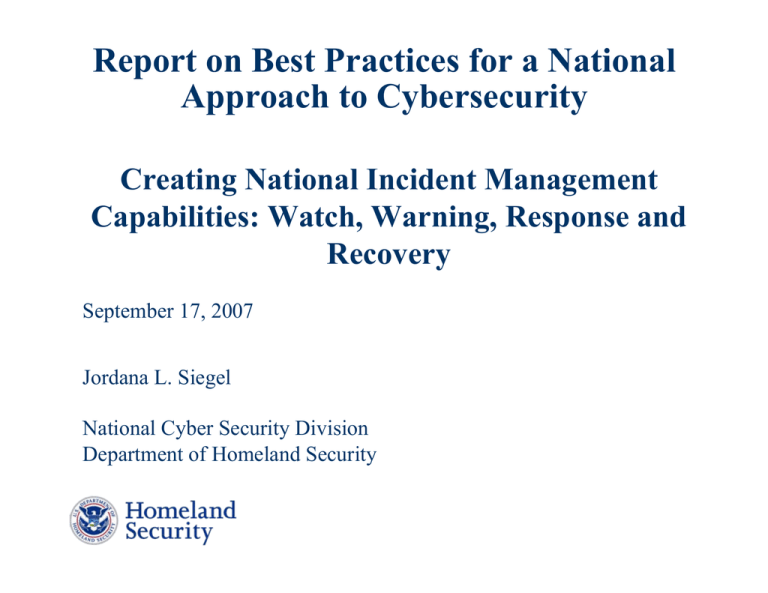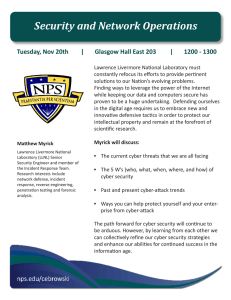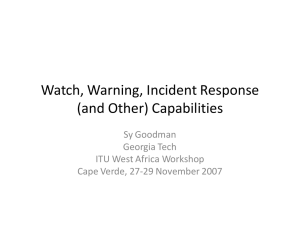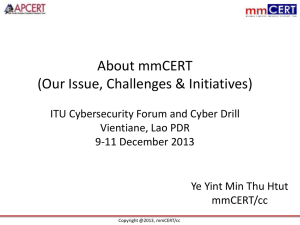Report on Best Practices for a National Approach to Cybersecurity
advertisement

Report on Best Practices for a National Approach to Cybersecurity Creating National Incident Management Capabilities: Watch, Warning, Response and Recovery September 17, 2007 Jordana L. Siegel National Cyber Security Division Department of Homeland Security National Incident Management Capabilities Government imperative: Greater reliance on Information and Communications Technology Greater potential impact from disruption Greater likelihood of disruption – growing threats Need for capabilities at the national level to prepare for, detect, manage, and respond to incidents that occur Effective incident management requires coordination across and collaboration with government, industry, academia, and with the international community Primary considerations: Funding, Human Resources, Training, Technological Capability, Stakeholder Relationships, Legal Requirements Overarching Goals Develop a coordinated national cyberspace security response system to prevent, detect, deter, respond to, and recover from cyber incidents Establish a National focal point for managing cyber incidents that brings together government and industry components to reduce both the risk and severity of incidents Participate in watch, warning, and incident response information sharing mechanisms Develop, test, and exercise emergency response plans, procedures, and protocols to ensure that government and nongovernment collaborators can coordinate effectively in a crisis Identify or Establish a National Computer Security Incident Response Team (N-CSIRT) Need a focal point within government Coordinates defense against and response to cyber incidents Serves as a single point of contact for cyber security incident reporting, coordination, and communications Mission should include analysis, warning, information sharing, vulnerability reduction, mitigation, and aiding national recovery efforts for critical infrastructure N-CSIRT Functions Detecting and identifying anomalous activity Analyzing cyber threats and vulnerabilities Disseminating early warning information Establishing trusted communications mechanisms and facilitating communications among stakeholders to share information and address cyber security issues Developing mitigation and response strategies and effecting a coordinated response to the incident Tracking and monitoring information to determine trends and long term remediation strategies Publicizing general cyber security best practices and guidance for incident response and prevention Establish Mechanisms for N-CSIRT Coordination with Stakeholders Need to disseminate and receive information, including current vulnerability and threat information Government Industry Academia Coordination mechanisms can take a number of forms: Maintain a website for exchanging information Provide information via mailing lists, newsletters, trends and analysis reports Produce publications that include alerts, tips, and information about various aspects of cyber security including new technologies, vulnerabilities, threats, and consequences Ensure N-CSIRT Coordination with Industry Establish collaborative relationships with industry to prepare for, detect, respond to, and recover from cyber incidents Encourage collaboration to foster sharing of operational information in real time Develop and implement programs that ensure the protection of proprietary data Define roles and responsibilities for incident management and establish protocols for use over time Establish Points of Contact with N-CSIRT Need to establish points of contact and working relationships with government entities, law enforcement, industry, and international partners for consultation, cooperation, and information exchange Build situational awareness Promote early warning of potential cyber incidents Enable exchange of information about trends, threats, and response activities Establish contacts based on departmental functions rather than individuals Maintain contacts for accurate dissemination of information and coordination Participate in International Cooperative and Information Sharing Activities Cyber incidents are not be confined to national borders Need to build trusted communications with other governments and foreign incident response communities N-CSIRT can establish formal and informal mechanisms to facilitate regular information sharing Develop N-CSIRT Tools and Procedures Need for technical tools and coordination plans Standard Operating Procedures (SOPs) Guidelines for internal and external operations Security policies for coordinating with stakeholders Implementation of secure information networks for CSIRT operations Secure communications Training for new staff Develop N-CSIRT Capability to Respond and Recover Prepare to address response and recovery efforts from largescale cyber attack Coordination is paramount Serves as central point of contact for coordination of operations across the government and with industry Need to develop plans and procedures in advance Conduct exercises to test plans and procedures Promote Responsible Disclosure Practices Need to protect sensitive vulnerability information Manage public disclosure when vulnerabilities in technology products are discovered Share vulnerabilities with vendors to facilitate the development of an adequate patch or solution from the vendor prior to potential public disclosure Questions?




